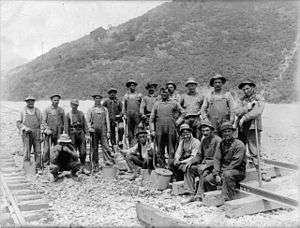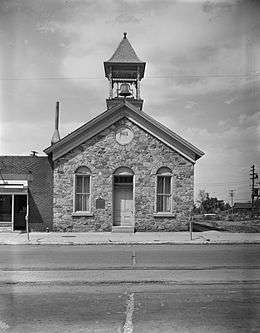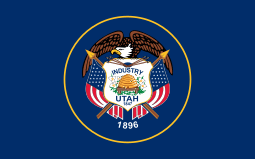Liberal Party (Utah)
The Liberal Party was a political party established in the latter half of the 1800s in Utah Territory before the national Democrats and Republicans established themselves in Utah in the early 1890s.
Liberal Party | |
|---|---|
| Founded | 1870 |
| Dissolved | 1896 |
| Succeeded by | American Party (not legal successor) |
| Ideology | Liberalism Social liberalism Anti-clericalism |
| Political position | Left-wing |
| |

The Liberal Party formed in 1870 to oppose The Church of Jesus Christ of Latter-day Saints (the LDS Church; popularly known as the "Mormons"), which dominated local politics via the People's Party. The Liberal Party thus represented opposition to government controlled by organized religious groups.
Though vastly outnumbered, the Liberal Party offered an opposing voice and won several local elections. Anti-Mormonism remained a central theme of the party until it disbanded in 1893 and became absorbed by the national parties.
Origins
The impetus for the setting up of the Liberal Party came from William S. Godbe, a successful businessman and Latter-day Saint who founded a journal called Utah Magazine in 1868. Godbe and several business associates challenged the economic policies of LDS Church President Brigham Young in the monthly periodical, especially Young's opposition to mining. When increasingly harsh condemnations aimed at LDS leadership appeared, the LDS Church excommunicated key "Godbeites" on October 25, 1869.
Corresponding during the winter, key Godbeites and non-Mormons made an uneasy alliance based on their shared opposition to LDS control over temporal matters in the territory.

The Liberal Party formed after a meeting on February 9, 1870 to select independent candidates for the Salt Lake City municipal election. The organizers billed the occasion as a meeting of the "people." A crowd of Latter-day Saints, encouraged by local bishops and a Deseret Evening News editorial, attended in numbers and nearly hijacked the meeting. After the LDS crowd had selected its own slate of candidates, frustrated Godbeite Eli B. Kelsey asked the Mormons to leave, which they did. The remaining non-Mormons selected an independent municipal ticket, forming the Liberal Party. Liberal leaders intended that their party's name suggest reform and evoke Britain's Liberal Party.
In response, Latter-day Saints formed the People's Party, a title that was selected to suggest popularity; it alluded to the Liberal Party's disrupted meeting of "the people". Latter-day Saints had previously won virtually all elections unchallenged.
Early Liberal Party speakers carefully avoided condemning LDS theology or polygamy, because several Godbeites themselves practised polygamy. Eli B. Kelsey and Henry W. Lawrence, both Godbeites, gained election as the first officers of the new party. Non-Mormons, including R. N. Baskin, George R. Maxwell, and Judge Dennis Toohy of Corinne, played an active role in the party but stayed in the background initially, hoping that ex-Mormon Godbeites would prove more effective leaders and candidates.
Godbeites believed they should reform Utah and the LDS Church to adopt more politically-progressive policies, but the non-Mormon element of the party took a more adversarial line. Non-Mormon partisans, especially miners and railroad workers, would increasingly dominate party leadership. Through the 1870s, the Liberal Party grew less appeasing of Godbeites and more openly anti-Mormon and anti-polygamy. Waning Godbeite influence was shown even by 1871, when Liberals Dennis Toohy and George R. Maxwell infuriated Godbeites at a party meeting by calling polygamists "dupes" and criminals of perverse sensuality.
Like many political parties of the time, the Liberal Party ran a newspaper although unofficially. Godbe's Utah Magazine became the Mormon Weekly Tribune and in 1873, three anti-Mormon newcomers from Kansas bought it and it became The Salt Lake Tribune. Until the Liberal Party disbanded in 1893, the Tribune would operate as the Liberal Party's de facto political organ. Similarly, the Deseret Evening News, owned by the LDS Church, often functioned as a People's Party organ.
History

Unsurprisingly, the Liberal Party performed poorly against the Mormon majority. In the 1870 Salt Lake City mayoral race, Liberal Henry W. Lawrence lost to Daniel H. Wells 321 to 2301. Statewide contests produced even more lopsided figures, with Liberals regularly failing to garner 10% of the vote. Although Liberals never won a single statewide office, the party served as a political foil and won several local elections, including:
- The so-called Tooele Republic in 1874
- Ogden, Utah in 1889
- Salt Lake City, Utah in 1890
When the party first formed in 1870, party officials tried to win offices in the town of Corrine and reasoned that they could more readily overwhelm the small local population. They failed but continued to scout other promising areas.
In Tooele County, perhaps the only non-Mormon majority in the territory existed. Its residents, mostly transitory miners, congregated in Utah after US Army General Patrick Edward Connor encouraged his men to prospect for minerals, which they discovered west of Salt Lake City in 1864.
The Liberal Party, campaigning voraciously in mining towns, won a disputed election in August 1874. The People's Party incumbents, citing fraud, refused to yield their positions even as US Marshals authorized by the 3rd District federal court attempted to intervene and install the Liberal candidates. Brigham Young advised his followers to abide by the federal court, which they finally did.
Liberals carried all offices in the county, which they called the Tooele Republic. Running unopposed in 1876, Liberals held the county until the Utah territorial legislature passed bills in 1878 that required voter registration and instituting women's suffrage. The Liberal Party, typically supported by male miners casually interested in politics, opposed both measures. In 1878 the Liberal electoral majority in Tooele County disappeared, and the People's Party regained control in 1879, after more than six months of Liberal procedural delays.
By 1880, the Liberal Party had become severely atrophied, but it was openly supported by the newly appointed strongly anti-Mormon territorial governor, Eli H. Murray. Thus, the 1880 statewide election for the US House of Representatives unexpectedly proved the closest that the Liberal Party got to sending a representative to Washington, DC.
The Liberal candidate, Allen G. Campbell, with 1357 votes, lost resoundingly to Mormon General Authority George Q. Cannon who had 18,567 votes. In fact, the election marked the all-time low percentage-wise showing for any Liberal House candidate. However, before Governor Murray certified the election, a protest on behalf of Campbell was filed. The protest listed a dozen claims, chiefly that Cannon, born in Liverpool, England; was not a naturalized alien, and was a polygamist, which was incompatible with the law and a delegate's oath of office. Murray agreed, and issued certification to Campbell in spite of the latter's poor showing.
George Q. Cannon, then in Washington, DC, argued that only Congress could decide on a member's qualifications. He furthermore received a certificate from sympathetic territorial election officials that stated he had received the most votes. The document convinced the House of Representatives clerk to enter Cannon's name on the roll and so Cannon began drawing delegate's salary.
Both Murray and Campbell traveled to Washington to dispute the seat. Each side battled over the position for over a year even despite the assassination and eventual death of President James Garfield. On February 25, 1882, the House of Representatives finally rejected both candidates. The House refused Cannon his seat not for his dubious citizenship but for his practice of polygamy.[1] The entire ordeal actually brought unfavorable national attention to the "Mormon Situation" on polygamy.
In a November 7, 1882 election to fill the vacated seat, the Liberal Party fielded Philip T. Van Zile, but the seat was ultimately won by John T. Caine, of the People's Party.[2] Of the 33,266 registered voters, 23,039 votes were cast for Caine, and Van Zile received 4884. About 12,000 people were excluded from registering based on suspicion of polygamy.[3]
National outrage against polygamy benefited the Liberal Party in Utah. On March 23, 1882, the anti-polygamy Edmunds Act became law. The even stronger Edmunds-Tucker Act, was enacted on March 3, 1887. Among other things, the acts required candidates and prospective voters to submit to an anti-polygamy oath. Enforcement of these bills furthermore put significant numbers of Latter-day Saint polygamists into federal prisons, including one built in Sugar House specifically for that purpose. The measures, which often brought punishment on anyone unwilling to take the oath, intimidated and decimated the Latter-day Saint voter pool.

The Liberal Party swept the city government of Ogden, Utah in 1889 but did not succeed in carrying the Weber County government. In 1890, the Liberal Party took Salt Lake City, and George M. Scott became the first non-Mormon mayor of Salt Lake, by a margin of 808 votes. Two years later, long-time Liberal stalwart R. N. Baskin became mayor on a "fusion ticket" between moderate Liberals and elements of the old People's Party.
Propelled by success in Salt Lake City and Ogden, the Liberal Party won a third of the Utah territorial legislature in the August 1891 election. That election proved particularly notable, as the People's Party had disbanded just prior to the election and urged all members to join national parties. Thus, non-Mormon Liberals ran (and several won) against mostly-Mormon Democrats and Republicans.
Disbanding
However, the Liberal Party had reached its twilight. In September 1890, the LDS Church issued the so-called 1890 Manifesto, which promised to end the practice of polygamy. The national support that the Liberals previously enjoyed for opposing polygamy in Utah thus disappeared. In 1893, all polygamists were given executive pardon, and statehood for Utah seemed imminent. Polygamy, often the focus of Liberal scorn, made the party irrelevant when Mormons abandoned the practice.
Following the lead of the People's Party 18 months earlier, most members of the Liberal Party joined national parties in early 1893 in anticipation of Utah statehood.
On January 4, 1896, Utah became the 45th state in the Union. Former Liberals continued to be involved in politics, and most of the Mormon majority continued to view them unfavorably.
The Deseret Evening News and other LDS papers characterized Liberal Party governments as wasteful. The party outspent revenue in Tooele, Ogden, and Salt Lake City, accumulating relatively large public debts. However, the Liberal Party characterized its expenditures as essential for civic improvements. In Salt Lake City, the Liberals constructed the city's first sewer, called the "gravity sewer," which the Deseret News characterized as graft. The Salt Lake Liberals also constructed an ornate and expensive joint Salt Lake City and County Building. Former Liberals such as Baskin defended the reputation and legacy of the Liberal Party well into the 20th century.
See also
Notes
- Tullidge, Edward Wheelock, History of Salt Lake City, 1886, Star printing company, chapter LXXXIX
- Tullidge, Edward Wheelock, History of Salt Lake City, 1886, Star printing company, chapter XC
- Appletons' Annual Cyclopædia and Register of Important Events of the Year 1883, Published 1884 by D. Appleton and company, page 813 (final subsection at end of Utah entry)
References
- Erickson, Velt G. (1948). The Liberal Party of Utah. University of Utah Master's Thesis.
- Malmquist, O. N. (1971). The first 100 years: a history of The Salt Lake Tribune, 1871–1971. Salt Lake City: Utah State Historical Society.
- Walker, Ronald W. (1998). Wayward Saints: The Godbeites and Brigham Young. Chicago: University of Illinois Press.
- Walker, Ronald (1994), "Godbeites", in Powell, Allan Kent (ed.), Utah History Encyclopedia, Salt Lake City, Utah: University of Utah Press, p. 674, ISBN 0874804256, OCLC 30473917
Further reading
- Durham, G. Homer (April 1947), "The Development of Political Parties in Utah: The First Phase", Utah Humanities Review, 1 (2): 122–33
- Carter, Kate B., ed. (1949), "Political Parties", Heart Throbs of the West, Daughters of Utah Pioneers, 10: 1–52
- Tullidge, Edward W. (1889), "Political History of the North", Tullidge's Histories, II, pp. 306–20
- Baskin, R. N. (1914), Reminiscences of Early Utah
